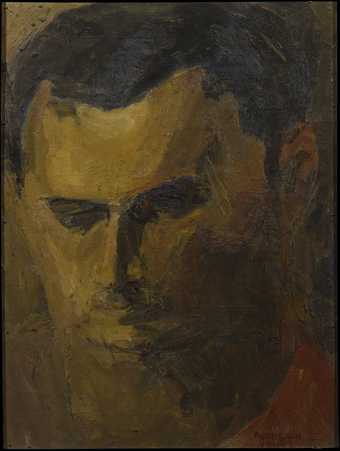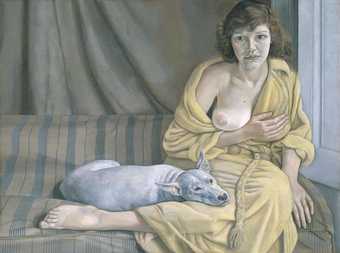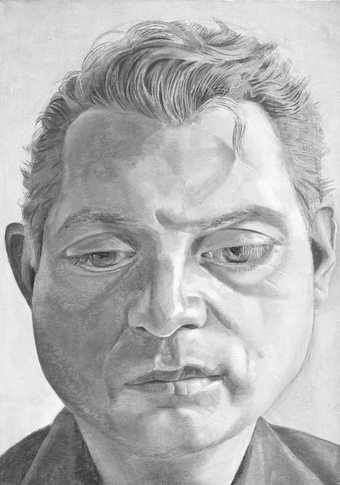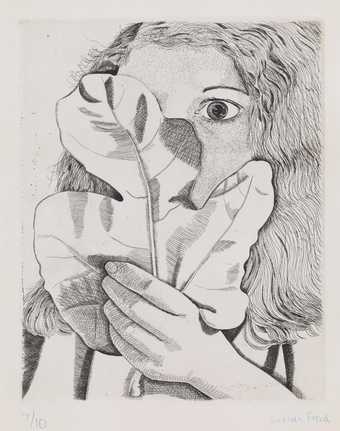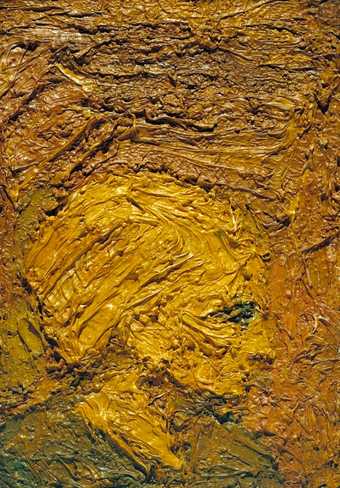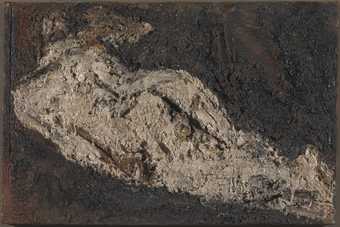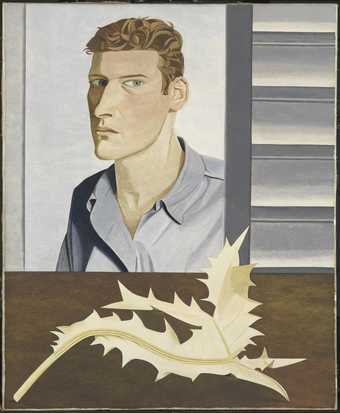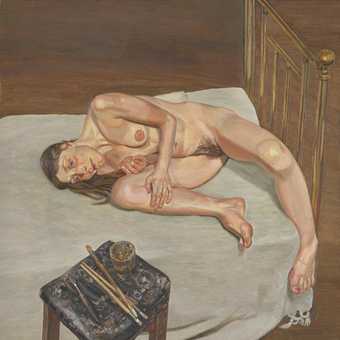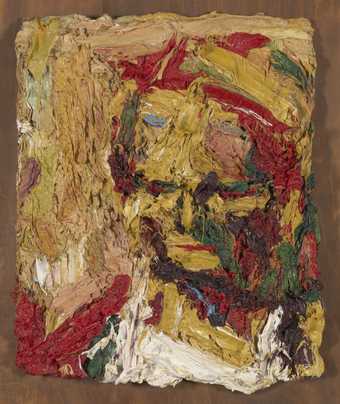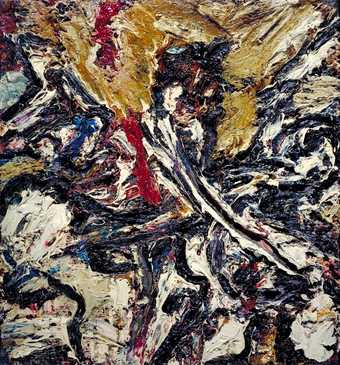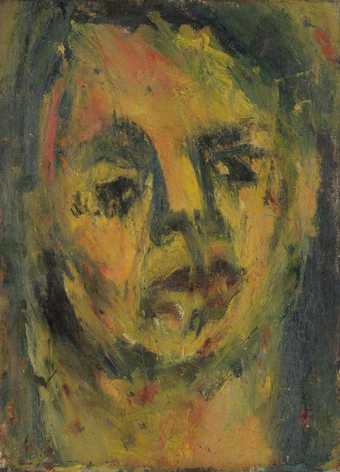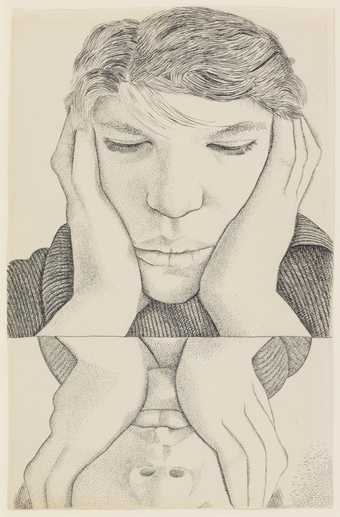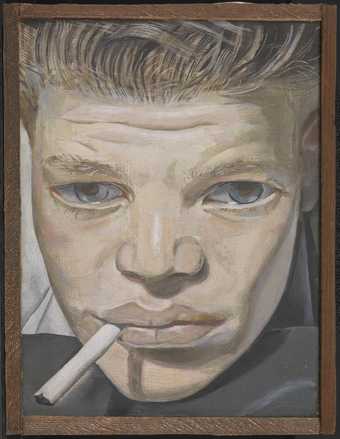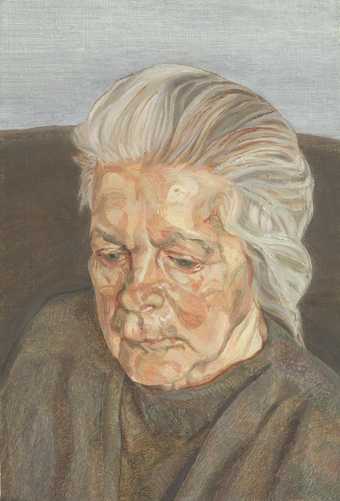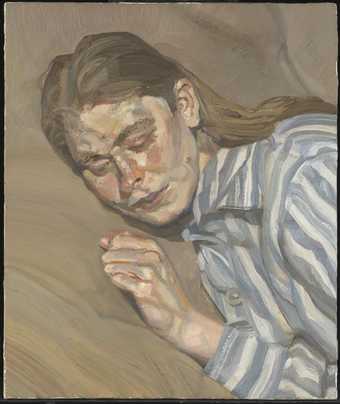
In Tate Britain
- Artist
- Lucian Freud 1922–2011
- Medium
- Oil paint on canvas
- Dimensions
- Support: 410 × 307 × 18 mm
frame: 509 × 404 × 58 mm - Collection
- Tate
- Acquisition
- Bequeathed by Simon Sainsbury 2006, accessioned 2008
- Reference
- T12617
Summary
Girl with a Kitten is one of eight portraits that Lucian Freud made of his first wife, Kathleen Garman (1926–2011), between 1947 and 1951. In this closely cropped composition, in which she is pictured against a beige wall, Garman holds a kitten by its neck in a tense grip, her knuckles especially prominent, seeming to half-strangle the animal without concern. Given that Garman was generally known as Kitty (a short form of Kathleen as well as a familiar term for a kitten), her treatment of the cat raises – and consciously leaves entirely unresolved – questions about her self-image. Garman stares into the middle distance with a pensive expression, while the kitten looks directly at the viewer. Every element in the painting is depicted with equal scrutiny, from the reflections in Garman’s pupils to the static energy of her wavy hair – a precision achieved through the use of fine sable brushes on finely woven canvas. A silvery light suffuses the image, granting the shadows in Garman’s pearl-like skin and the soft blue garment she wears a chill uniformity.
In 1946–7 Freud traveled to Paris and Greece, returning to London in February 1947. Here he began a relationship with Kitty Garman, the eldest daughter of the sculptor Jacob Epstein and the model and collector Kathleen Garman. The subsequent marriage between Freud and Kitty was short-lived – they wed in the spring of 1948 and divorced in 1952 after having two daughters. Freud’s portraits of Kitty include four oil paintings – beginning with Girl in a Dark Jacket 1947 and finishing with Girl with a White Dog 1950–1 (Tate N06039) – as well as two etchings, a work in pastel, and a drawing in ink and crayon.
The portraits of Kitty Garman mark the culmination of Freud’s early portrait style, which evoked the tradition of Neue Sachlichkeit (New Objectivity) – a form of realist painting that emerged in Germany in the early 1920s, and was characterised by its sharp and unsentimental style. (Freud, grandson of the psychoanalyst Sigmund Freud, was born in Berlin in 1922 and came to Britain in 1933, and studied at a number of art schools during the war.) The intensity of Girl with a Kitten, and especially the manner in which Garman dominates the pictorial frame, might also stem from Freud’s approach to his sitters at this time, which had distinct psychological and spatial aspects. The artist admits his early portraits emerged from his ‘visual aggression’ with sitters. He claimed, ‘I would sit very close and stare. It could be uncomfortable for both of us.’ (Quoted in Michael Auping, ‘Freud from America’, in Howgate, Auping and Richardson 2012, p.41.) By the mid-1950s Freud had abandoned the highly controlled style of portraiture seen in this work, and he began to paint in a looser and more viscous style.
Girl with a Kitten is dated September 1947 on its reverse and was first exhibited at the London Gallery in October 1947, in a show titled Lucian Freud and John Craxton. It next appeared at the Institute of Contemporary Arts in London in 1950, as part of the group exhibition London/Paris: New Trends in Painting and Sculpture. In 1954 it was exhibited at the Venice Biennale (where it was called Girl with Cat, the only time it appears to have been displayed under that title), where Freud was selected to represent Britain along with Ben Nicholson and Francis Bacon. In the catalogue for the British Pavilion, John Rothenstein, then director of the Tate Gallery, wrote of Freud: ‘For many there is something cold and unrelenting in the long, unblinking stare he gives his subjects. It is not a sentimental or even a tender stare: it is a stare of sheer fascination’ (John Rothenstein, in Nicholson, Bacon, Freud, exhibition catalogue, British Pavilion, Venice Biennale, London 1954, unpaginated).
Previously owned by Freud’s elder brother, Stephen, Girl with a Kitten later entered the collection of philanthropist and collector Simon Sainsbury, himself the subject of a portrait by Freud (Red-Haired Man with Glasses 1987–8). Alongside two other Freud paintings, Boy Smoking 1950–1 (Tate T12618) and The Painter’s Mother IV 1973 (Tate T12619), it became part of the Simon Sainsbury Bequest in 2006, in which eighteen works were donated to Tate and the National Gallery. Girl with a Kitten was chosen as the cover image for the catalogue of a 2008 display of the Bequest.
Further reading
Lawrence Gowing, Lucian Freud, London 1982, p.81, reproduced p.75.
Andrew Wilson (ed.), The Simon Sainsbury Bequest to Tate and the National Gallery, exhibition catalogue, Tate Britain, London 2008, pp.104–20.
Sarah Howgate, Michael Auping and John Richardson, Lucian Freud Portraits, exhibition catalogue, National Portrait Gallery, London 2012, p.41, reproduced p.68.
Lee Hallman
January 2014
Supported by Christie’s.
Does this text contain inaccurate information or language that you feel we should improve or change? We would like to hear from you.
Display caption
In 1947 Lucian Freud fell in love with Kitty Garman, daughter of Kathleen Garman and Jacob Epstein, and the subject of eight portraits by Freud that chart their short marriage. In this closely-cropped composition, the kitten - serving as a namesake for Garman - is gripped tightly by the neck as it stares straight ahead, while Garman averts her gaze. Girl with a Kitten shows the way that Freud sought to embody character, rather than just illustrate likeness, and to create a sense of dramatic tension.
Gallery label, September 2016
Does this text contain inaccurate information or language that you feel we should improve or change? We would like to hear from you.
Explore
- people(22,072)
-
- actions: processes and functions(2,161)
-
- carrying / holding(866)
- adults(20,120)
-
- woman(9,110)
- body(4,878)
-
- head / face(2,497)
You might like
-
Frank Auerbach Portrait of Leon Kossoff
1951 -
Lucian Freud Girl with a White Dog
1951–1952 -
Lucian Freud Francis Bacon
1952 -
Lucian Freud Girl with a Fig Leaf
1947 -
Frank Auerbach Small Head of E.O.W.
1957–8 -
Frank Auerbach E.O.W. Nude
1953–4 -
Lucian Freud Man with a Thistle (Self-Portrait)
1946 -
Lucian Freud Naked Portrait
1972–3 -
Frank Auerbach Head of E.O.W. I
1960 -
Frank Auerbach Study after Titian I
1965 -
Leon Kossoff Self-Portrait
c.1952 -
Lucian Freud Narcissus
1948 -
Lucian Freud Boy Smoking
1950–1 -
Lucian Freud The Painter’s Mother IV
1973 -
Lucian Freud Girl in a Striped Nightshirt
1983–5

